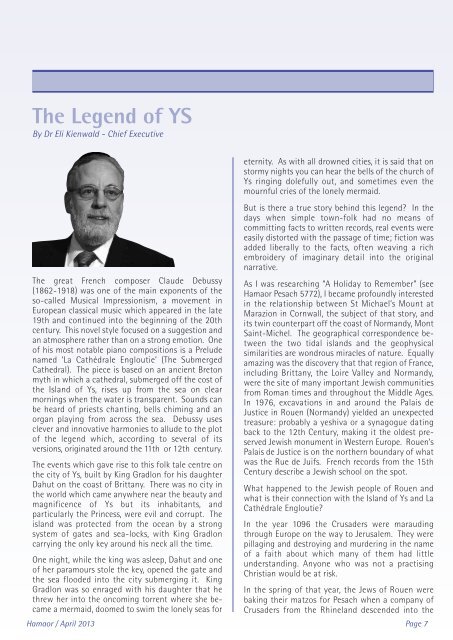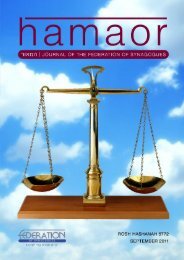Pesach 5773 - 18/03/2013 - Federation Of Synagogues
Pesach 5773 - 18/03/2013 - Federation Of Synagogues
Pesach 5773 - 18/03/2013 - Federation Of Synagogues
You also want an ePaper? Increase the reach of your titles
YUMPU automatically turns print PDFs into web optimized ePapers that Google loves.
The Legend of YS<br />
By Dr Eli Kienwald - Chief Executive<br />
eternity. As with all drowned cities, it is said that on<br />
stormy nights you can hear the bells of the church of<br />
Ys ringing dolefully out, and sometimes even the<br />
mournful cries of the lonely mermaid.<br />
The great French composer Claude Debussy<br />
(<strong>18</strong>62-19<strong>18</strong>) was one of the main exponents of the<br />
so-called Musical Impressionism, a movement in<br />
European classical music which appeared in the late<br />
19th and continued into the beginning of the 20th<br />
century. This novel style focused on a suggestion and<br />
an atmosphere rather than on a strong emotion. One<br />
of his most notable piano compositions is a Prelude<br />
named ‘La Cathédrale Engloutie’ (The Submerged<br />
Cathedral). The piece is based on an ancient Breton<br />
myth in which a cathedral, submerged off the cost of<br />
the Island of Ys, rises up from the sea on clear<br />
mornings when the water is transparent. Sounds can<br />
be heard of priests chanting, bells chiming and an<br />
organ playing from across the sea. Debussy uses<br />
clever and innovative harmonies to allude to the plot<br />
of the legend which, according to several of its<br />
versions, originated around the 11th or 12th century.<br />
The events which gave rise to this folk tale centre on<br />
the city of Ys, built by King Gradlon for his daughter<br />
Dahut on the coast of Brittany. There was no city in<br />
the world which came anywhere near the beauty and<br />
magnificence of Ys but its inhabitants, and<br />
particularly the Princess, were evil and corrupt. The<br />
island was protected from the ocean by a strong<br />
system of gates and sea-locks, with King Gradlon<br />
carrying the only key around his neck all the time.<br />
One night, while the king was asleep, Dahut and one<br />
of her paramours stole the key, opened the gate and<br />
the sea flooded into the city submerging it. King<br />
Gradlon was so enraged with his daughter that he<br />
threw her into the oncoming torrent where she became<br />
a mermaid, doomed to swim the lonely seas for<br />
Hamaor / April <strong>2013</strong><br />
But is there a true story behind this legend? In the<br />
days when simple town-folk had no means of<br />
committing facts to written records, real events were<br />
easily distorted with the passage of time; fiction was<br />
added liberally to the facts, often weaving a rich<br />
embroidery of imaginary detail into the original<br />
narrative.<br />
As I was researching “A Holiday to Remember” (see<br />
Hamaor <strong>Pesach</strong> 5772), I became profoundly interested<br />
in the relationship between St Michael’s Mount at<br />
Marazion in Cornwall, the subject of that story, and<br />
its twin counterpart off the coast of Normandy, Mont<br />
Saint-Michel. The geographical correspondence between<br />
the two tidal islands and the geophysical<br />
similarities are wondrous miracles of nature. Equally<br />
amazing was the discovery that that region of France,<br />
including Brittany, the Loire Valley and Normandy,<br />
were the site of many important Jewish communities<br />
from Roman times and throughout the Middle Ages.<br />
In 1976, excavations in and around the Palais de<br />
Justice in Rouen (Normandy) yielded an unexpected<br />
treasure: probably a yeshiva or a synagogue dating<br />
back to the 12th Century, making it the oldest preserved<br />
Jewish monument in Western Europe. Rouen’s<br />
Palais de Justice is on the northern boundary of what<br />
was the Rue de Juifs. French records from the 15th<br />
Century describe a Jewish school on the spot.<br />
What happened to the Jewish people of Rouen and<br />
what is their connection with the Island of Ys and La<br />
Cathédrale Engloutie?<br />
In the year 1096 the Crusaders were marauding<br />
through Europe on the way to Jerusalem. They were<br />
pillaging and destroying and murdering in the name<br />
of a faith about which many of them had little<br />
understanding. Anyone who was not a practising<br />
Christian would be at risk.<br />
In the spring of that year, the Jews of Rouen were<br />
baking their matzos for <strong>Pesach</strong> when a company of<br />
Crusaders from the Rhineland descended into the<br />
Page 7










